NMN-VD: A Neural Module Network for Visual Dialog
Abstract
1. Introduction
2. Related Work
2.1. Visual Question and Answering (VQA)
2.2. Visual Dialog
2.3. Neural Module Network
3. Neural Module Network Model
3.1. Model Overview
3.2. Neural Network Module
3.3. Refer Module
3.4. Processing Impersonal Pronouns
3.5. Compare Module
3.6. Find Module
4. Implementation and Experiments
4.1. Datasets and Model Training
4.2. Performance Evaluation of Each Module (Ablation Study)
4.3. Performance Comparison with Existing Models
4.4. Qualitative Evaluation
5. Conclusions
Author Contributions
Funding
Institutional Review Board Statement
Informed Consent Statement
Data Availability Statement
Conflicts of Interest
References
- Agrawal, A.; Lu, J.; Antol, S.; Mitchell, M.; Zitnick, C.L.; Parikh, D.; Batra, D. VQA: Visual question answering. Int. J. Comput. Vis. 2017, 123, 4–31. [Google Scholar] [CrossRef]
- Das, A.; Kottur, S.; Gupta, K.; Singh, A.; Yadav, D.; Moura, J.M.F.; Parikh, D.; Batra, D. Visual dialog. In Proceedings of the IEEE Computer Vision and Pattern Recognition, CVPR, IEEE Xplore, Honolulu, HI, USA, 22–25 July 2017; pp. 326–335. [Google Scholar] [CrossRef]
- Gan, Z.; Cheng, Y.; Kholy, A.E.; Li, L.; Liu, J.; Gao, J. Multi-step reasoning via recurrent dual attention for visual dialog. In Proceedings of the 57th Annual Meeting of the Association for Computational Linguistics; Association for Computational Linguistics: Florence, Italy, 2019; pp. 6463–6474. [Google Scholar] [CrossRef]
- Guo, D.; Xu, C.; Tao, D. Image-question-answer synergistic network for visual dialog. In Proceedings of the IEEE Computer Vision and Pattern Recognition, CVPR, IEEE Xplore, Long Beach, CA, USA, 16–20 June 2019; pp. 10434–10443. [Google Scholar] [CrossRef]
- Kottur, S.; Moura, J.M.; Parikh, D.; Batra, D.; Rohrbach, M. Visual coreference resolution in visual dialog using neural module networks. In Proceedings of the 15th European Conference on Computer Vision, ECCV, Munich, Germany, 8–14 September 2018; pp. 153–169. [Google Scholar] [CrossRef]
- Kang, G.; Lim, J.; Zhang, B.T. Dual attention networks for visual reference resolution in visual dialog. In Proceedings of the Conference on Empirical Methods in Natural Language Processing, EMNLP, Hong Kong, China, 3–7 November 2019; pp. 2024–2033. [Google Scholar] [CrossRef]
- Lu, J.; Kannan, A.; Yang, J.; Parikh, D.; Batra, D. Best of both worlds: Transferring knowledge from discriminative learning to a generative visual dialog model. In Proceedings of the 31st Conference on Neural Information Processing Systems, NIPS, Long Beach, CA, USA, 4–9 December 2017; pp. 314–324. [Google Scholar]
- Niu, Y.; Zhang, H.; Zhang, M.; Zhang, J.; Lu, Z.; Wen, J.-R. Recursive visual attention in visual dialog. In Proceedings of the IEEE Computer Vision and Pattern Recognition, CVPR, IEEE Xplore, Long Beach, CA, USA, 16–20 June 2019; pp. 6679–6688. [Google Scholar] [CrossRef]
- Seo, P.H.; Lehrmann, A.; Han, B.; Sigal, L. Visual reference resolution using attention memory for visual dialog. In Proceedings of the 31st Conference on Neural Information Processing Systems, NIPS, Long Beach, CA, USA, 4–9 December 2017; pp. 3719–3729. [Google Scholar]
- Wu, Q.; Wang, P.; Shen, C.; Reid, I.; van den Hegel, A. Are you talking to me? Reasoned visual dialog generation through adversarial learning. In Proceedings of the IEEE Computer Vision and Pattern Recognition, CVPR, IEEE Xplore, Salt Lake City, UT, USA, 18–23 June 2018; pp. 6106–6115. [Google Scholar] [CrossRef]
- Yang, T.; Zha, Z.J.; Zhang, H. Making history matter: History-advantage sequence training for visual dialog. In Proceedings of the International Conference on Computer Vision, ICCV, Seoul, Korea, 27 October–2 November 2019; pp. 2561–2569. [Google Scholar] [CrossRef]
- Anderson, P.; He, X.; Buehler, C.; Teney, D.; Johnson, M.; Gould, S.; Zhang, L. Bottom-up and top-down attention for image captioning and VQA. In Proceedings of the IEEE Computer Vision and Pattern Recognition, CVPR, IEEE Xplore, Salt Lake City, UT, USA, 18–23 June 2018; pp. 6077–6086. [Google Scholar]
- Chen, K.; Wang, J.; Chen, L.-C.; Gao, H.; Xu, W.; Nevatia, R. ABC-CNN: An attention based convolutional neural network for visual question answering. arXiv 2015, arXiv:1511.05960. [Google Scholar]
- Ilievski, I.; Yan, S.; Feng, J. A focused dynamic attention model for visual question answering. arXiv 2016, arXiv:1604.01485. [Google Scholar]
- Xu, H.; Saenko, K. Ask, attend and answer: Exploring question-guided spatial attention for visual question answering. In Proceedings of the 14th European Conference on Computer Vision, ECCV, Amsterdam, The Netherlands, 8–16 October 2016; pp. 451–466. [Google Scholar] [CrossRef]
- Yang, Z.; He, X.; Gao, J.; Smola, A. Stacked attention networks for image question answering. In Proceedings of the IEEE Computer Vision and Pattern Recognition, CVPR, IEEE Xplore, Las Vegas, NE, USA, 27–30 June 2016; pp. 21–29. [Google Scholar] [CrossRef]
- Lu, J.; Yang, J.; Batra, D.; Parikh, D. Hierarchical question-image co-attention for visual question answering. In Proceedings of the 30th Conference on Neural Information Processing Systems, NIPS, Barcelona, Spain, 5–10 December 2016; pp. 289–297. [Google Scholar]
- Lao, M.; Guo, Y.; Wang, H.; Zhang, X. Cross-modal multistep fusion network with co-attention for visual question answering. IEEE Access 2018, 6, 31516–31524. [Google Scholar] [CrossRef]
- Nam, H.; Ha, J.W.; Kim, J. Dual attention networks for multimodal reasoning and matching. In Proceedings of the IEEE Computer Vision and Pattern Recognition, CVPR, IEEE Xplore, Honolulu, HI, USA, 22–25 July 2017; pp. 299–307. [Google Scholar] [CrossRef]
- Yu, D.; Fu, J.; Mei, T.; Rui, Y. Multi-level attention networks for visual question answering. In Proceedings of the IEEE Computer Vision and Pattern Recognition, CVPR, IEEE Xplore, Honolulu, HI, USA, 22–25 July 2017; pp. 4709–4717. [Google Scholar] [CrossRef]
- Yang, C.; Jiang, M.; Jiang, B.; Zhou, W.; Li, K. Co-attention network with question type for visual question answering. IEEE Access 2019, 7, 40771–40781. [Google Scholar] [CrossRef]
- Idan, S.; Yu, S.; Hazan, T.; Schwing, A. Factor graph attention. In Proceedings of the IEEE Computer Vision and Pattern Recognition, CVPR, IEEE Xplore, Long Beach, CA, USA, 16–20 June 2019; pp. 2039–2048. [Google Scholar] [CrossRef]
- Park, S.; Whang, T.; Yoon, Y.; Lim, H. Multi-view attention network for visual dialog. arXiv 2020, arXiv:2004.14025. [Google Scholar]
- Kirsch, L.; Kunze, J.; Barber, I. Modular networks: Learning to decompose neural computation. In Proceedings of the 32nd International Conference on Neural Information Processing Systems, NIPS, Montreal, QC, Canada, 3–8 December 2018; pp. 2408–2418. [Google Scholar]
- Neelakantan, A.; Le, Q.V.; Sutskever, I. Neural programmer: Inducing latent programs with gradient descent. In Proceedings of the 4th International Conference on Learning Representations, ICLR, San Juan, Puerto Rico, 2–4 May 2016. [Google Scholar]
- Andreas, J.; Rohrbach, M.; Darrell, T.; Klein, D. Neural module networks. In Proceedings of the IEEE Computer Vision and Pattern Recognition, CVPR, IEEE Xplore, Las Vegas, NE, USA, 27–30 June 2016; pp. 39–48. [Google Scholar] [CrossRef]
- Hu, R.; Andreas, J.; Rohrbach, M.; Darell, T.; Saenko, K. Learning to reason: End-to-end module networks for visual question answering. In Proceedings of the IEEE International Conference on Computer Vision ICCV, IEEE Xplore, Venice, Italy, 22–29 October 2017; pp. 804–813. [Google Scholar] [CrossRef]
- Hu, R.; Andreas, J.; Darrell, T.; Saenko, K. Explainable neural computation via stack neural module networks. In Proceedings of the 15th European Conference on Computer Vision, ECCV, Munich, Germany, 8–14 September 2018; pp. 53–69. [Google Scholar] [CrossRef]
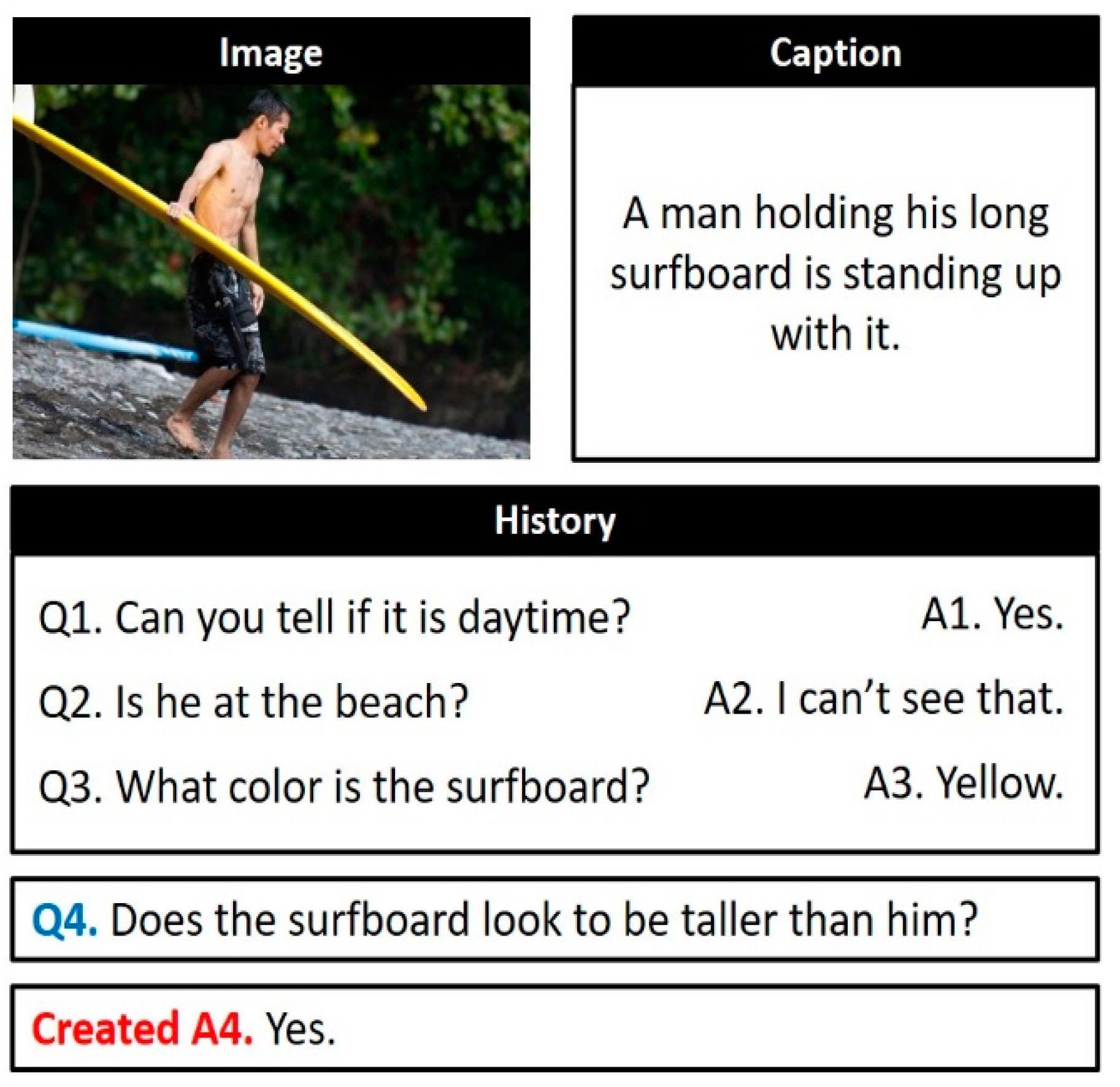
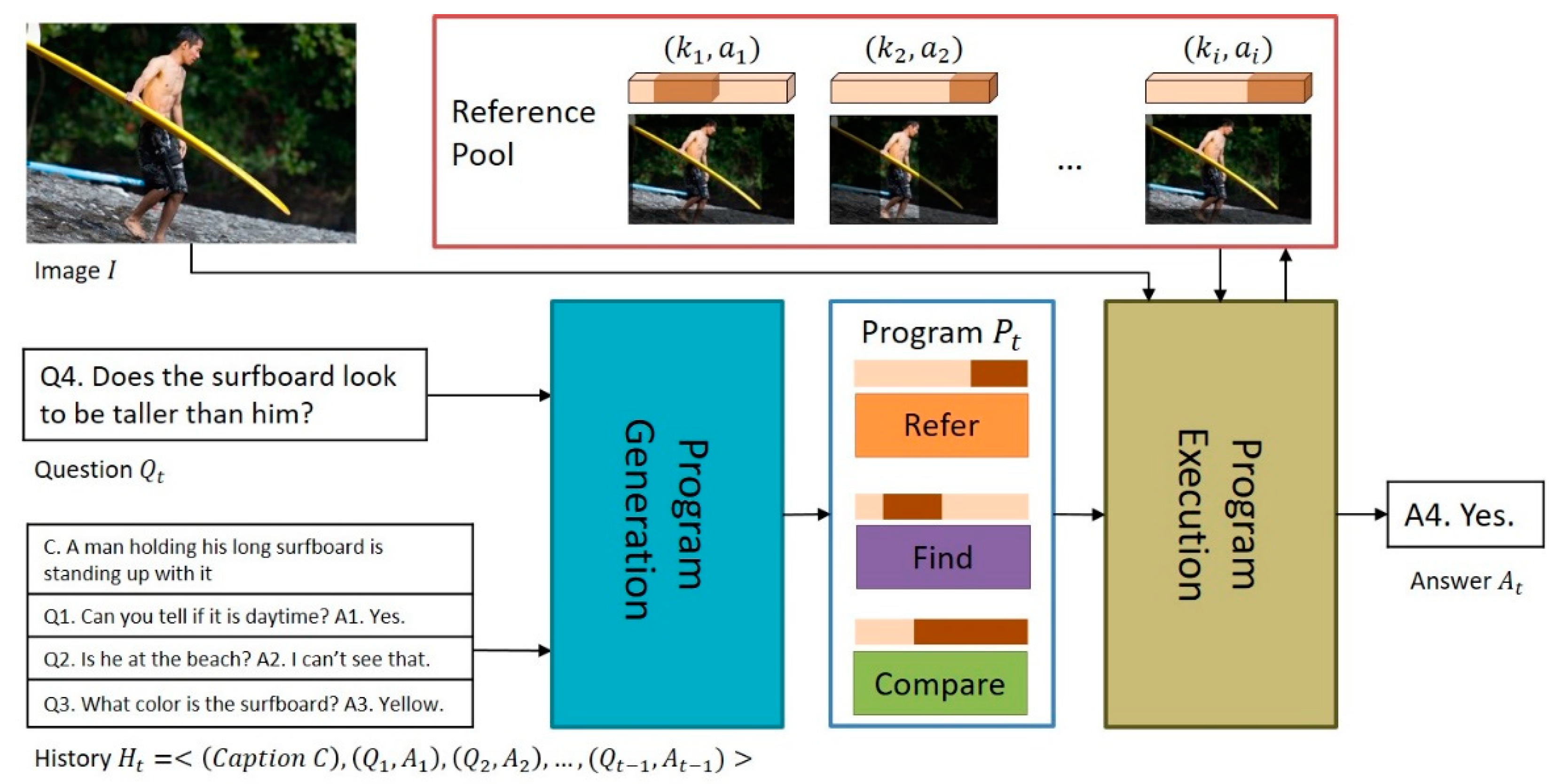


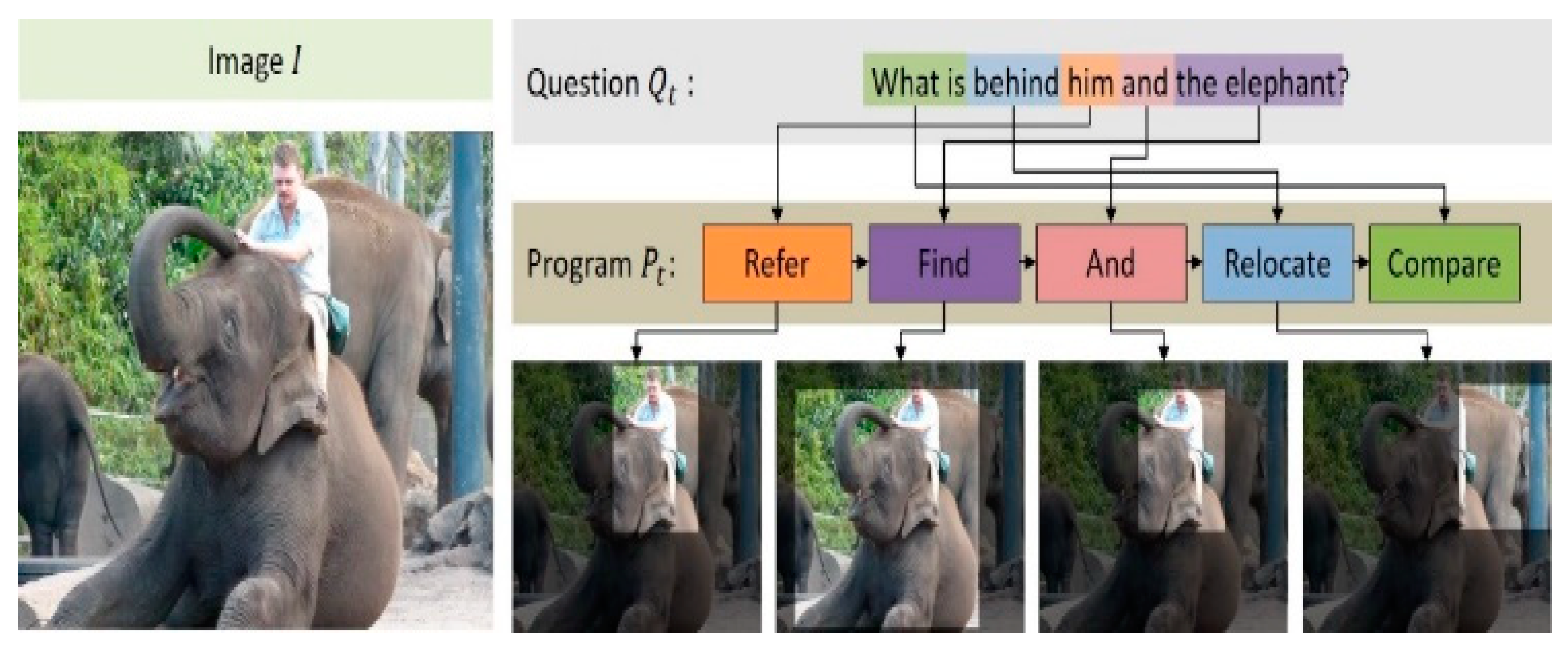
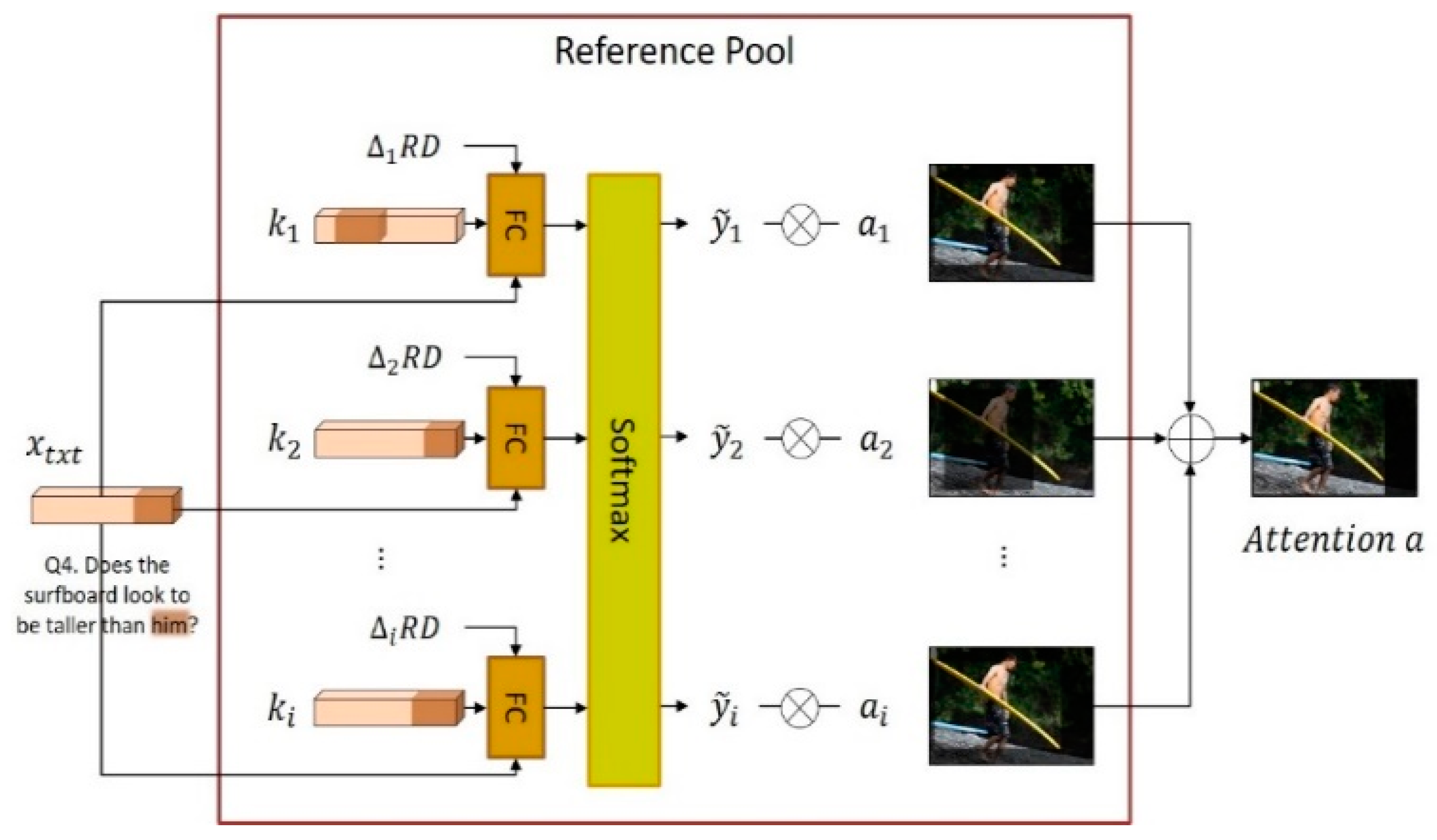



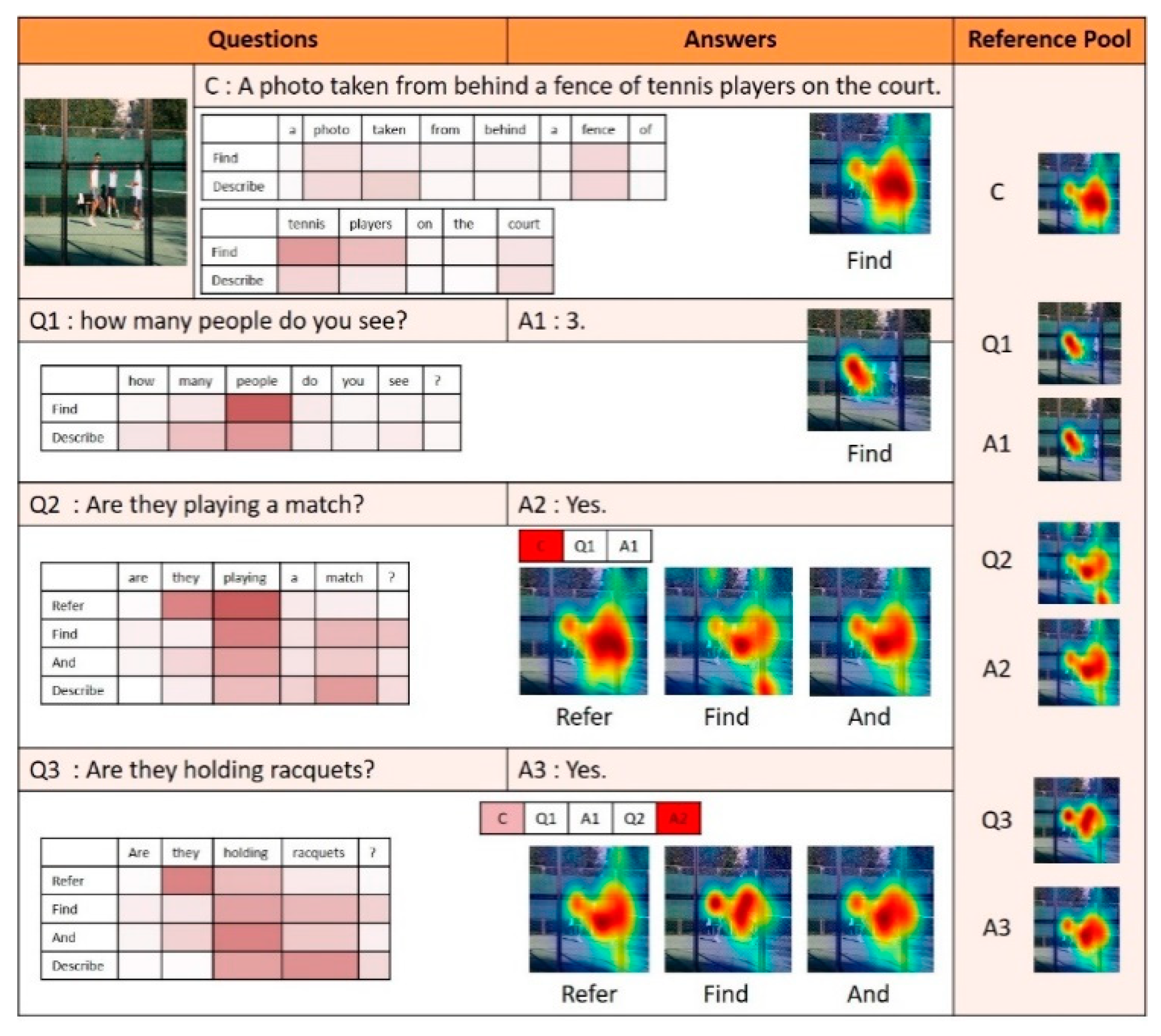
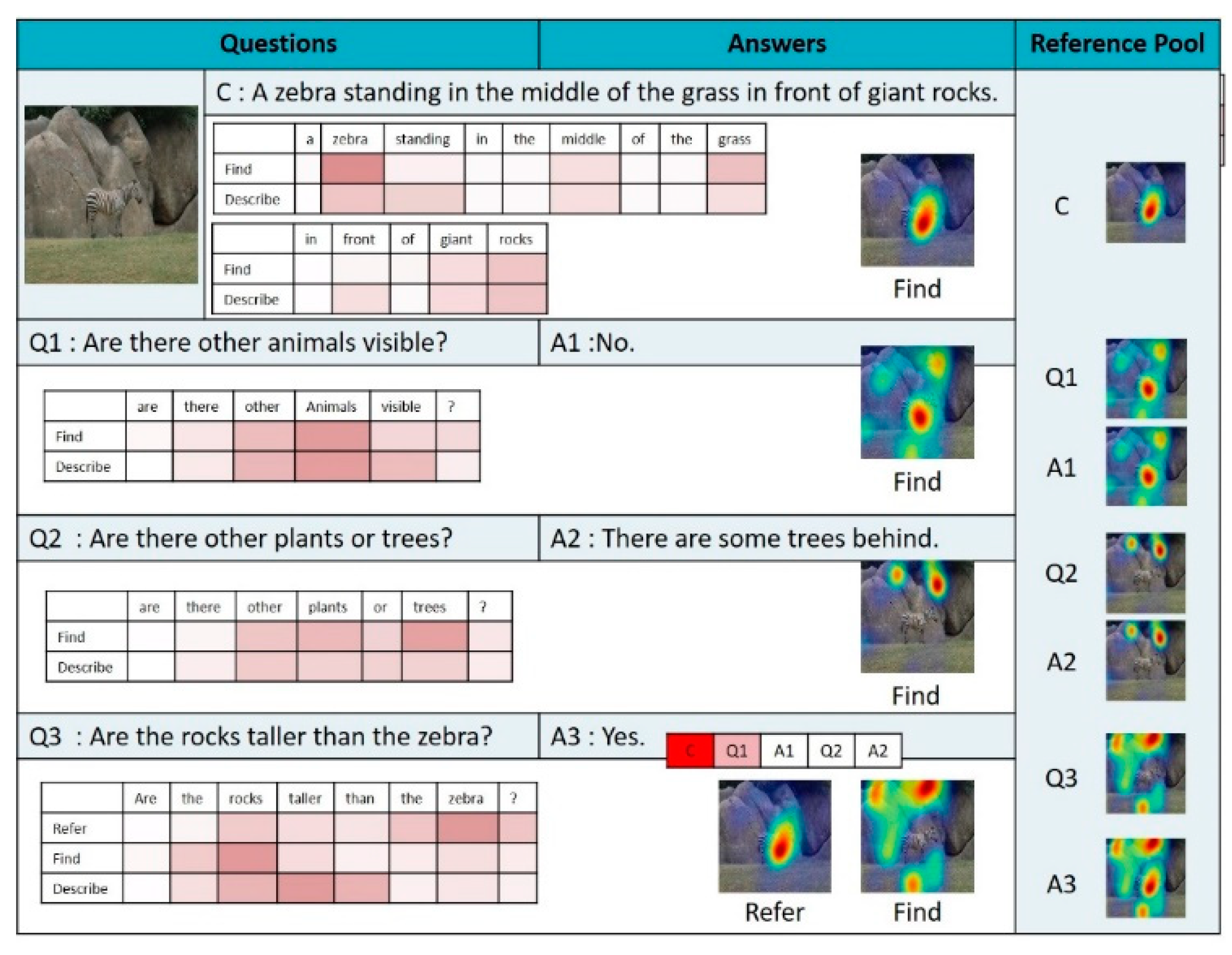
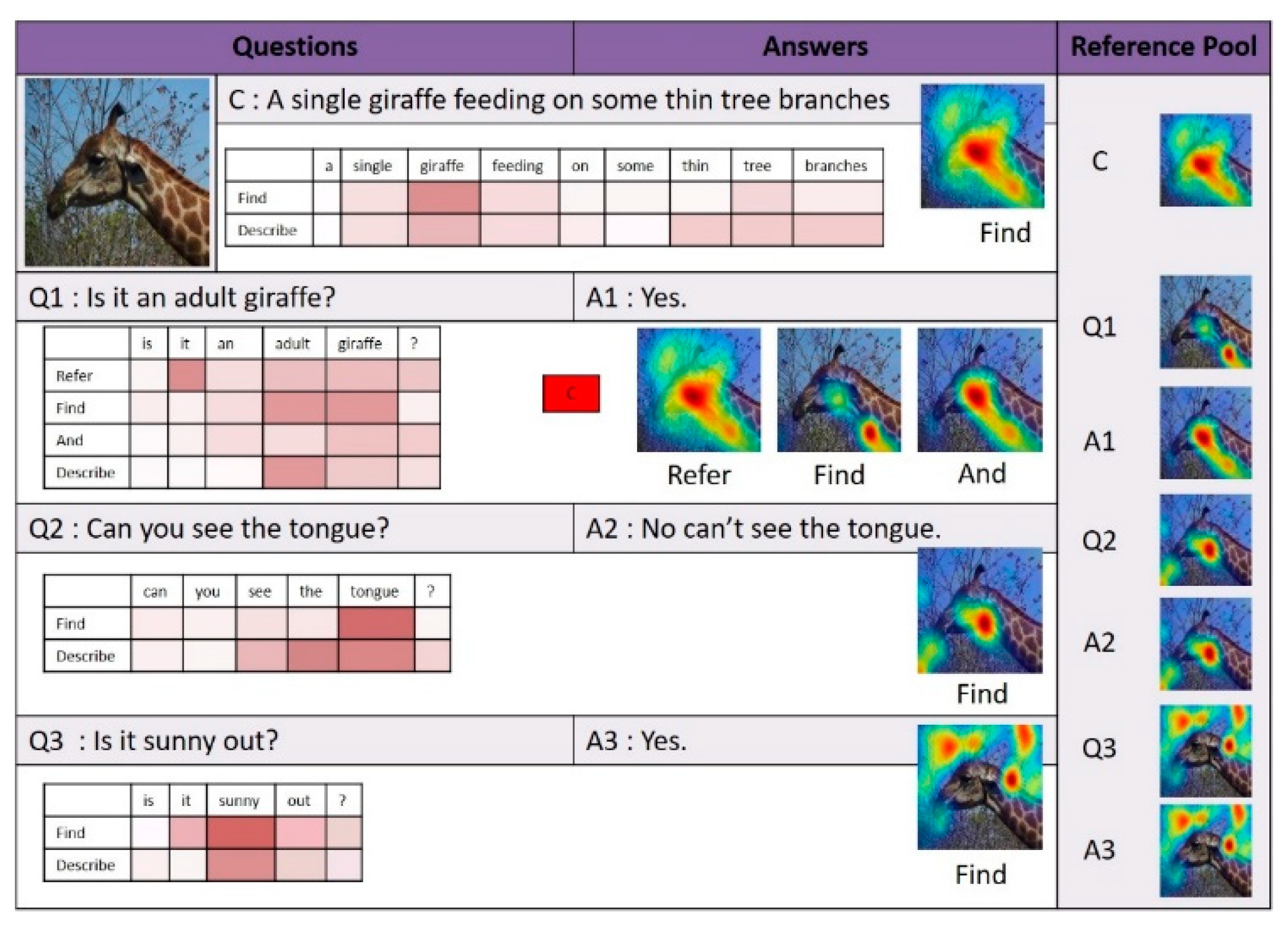
| Module | Inputs | Output | Function |
|---|---|---|---|
| Find | Attention | ||
| Relocate | Attention | ||
| And | Attention | ||
| Refer | Attention | ||
| Describe | Context | ||
| Compare | Context |
| Attention | MRR | R@1 | R@5 | R@10 | Mean |
|---|---|---|---|---|---|
| Single attention | 64.10 | 50.92 | 80.18 | 88.81 | 4.53 |
| Dual attention | 64.50 | 51.31 | 80.52 | 89.04 | 4.35 |
| Triple attention | 64.70 | 51.56 | 80.57 | 89.07 | 4.32 |
| Quad attention | 64.50 | 51.41 | 80.50 | 88.99 | 4.35 |
| Dataset | Refer Modules | MRR | R@1 | R@5 | R@10 | Mean |
|---|---|---|---|---|---|---|
| VisDialR v0.9 | Refer | 64.80 | 51.64 | 80.87 | 89.28 | 4.29 |
| Refer + Impersonality | 64.90 | 51.70 | 80.94 | 89.35 | 4.27 | |
| VisDial v0.9 | Refer | 64.70 | 51.56 | 80.57 | 89.07 | 4.32 |
| Refer + Impersonality | 64.90 | 51.74 | 80.88 | 89.29 | 4.30 |
| Compare Modules | MRR | R@1 | R@5 | R@10 | Mean |
|---|---|---|---|---|---|
| No compare | 64.90 | 51.74 | 80.88 | 89.29 | 4.30 |
| Compare (Inner Product) | 64.50 | 51.28 | 80.50 | 88.98 | 4.36 |
| Compare (Or) | 64.80 | 51.67 | 80.79 | 89.24 | 4.30 |
| Compare (Ours) | 64.90 | 51.82 | 80.88 | 89.34 | 4.27 |
| VisDial v1.0 | VisDial v0.9 | ||||||||||
|---|---|---|---|---|---|---|---|---|---|---|---|
| Model | NDCG | MRR | R@1 | R@5 | R@10 | Mean | MRR | R@1 | R@5 | R@10 | Mean |
| LF [2] | 45.31 | 55.42 | 40.95 | 72.45 | 82.83 | 5.95 | 58.07 | 43.82 | 74.68 | 84.07 | 5.78 |
| HRE [2] | 45.46 | 54.16 | 39.93 | 70.45 | 81.50 | 6.41 | 58.68 | 44.82 | 74.81 | 84.36 | 5.66 |
| MN [2] | 47.50 | 55.49 | 40.98 | 72.30 | 83.30 | 5.92 | 59.65 | 45.55 | 76.22 | 85.37 | 5.46 |
| HCIAE [7] | - | - | - | - | - | - | 62.22 | 48.48 | 78.75 | 87.59 | 4.81 |
| AMEM [9] | - | - | - | - | - | - | 62.27 | 48.53 | 78.66 | 87.43 | 4.86 |
| CoAtt [10] | - | - | - | - | - | - | 63.98 | 50.29 | 80.18 | 88.81 | 4.47 |
| CorefNMN [5] | 54.70 | 61.50 | 47.55 | 78.10 | 88.80 | 4.40 | 64.10 | 50.92 | 80.18 | 88.81 | 4.53 |
| NMN-VD (Ours) | 56.90 | 63.00 | 49.23 | 79.81 | 88.89 | 4.31 | 64.90 | 51.82 | 80.88 | 89.34 | 4.27 |
Publisher’s Note: MDPI stays neutral with regard to jurisdictional claims in published maps and institutional affiliations. |
© 2021 by the authors. Licensee MDPI, Basel, Switzerland. This article is an open access article distributed under the terms and conditions of the Creative Commons Attribution (CC BY) license (http://creativecommons.org/licenses/by/4.0/).
Share and Cite
Cho, Y.; Kim, I. NMN-VD: A Neural Module Network for Visual Dialog. Sensors 2021, 21, 931. https://doi.org/10.3390/s21030931
Cho Y, Kim I. NMN-VD: A Neural Module Network for Visual Dialog. Sensors. 2021; 21(3):931. https://doi.org/10.3390/s21030931
Chicago/Turabian StyleCho, Yeongsu, and Incheol Kim. 2021. "NMN-VD: A Neural Module Network for Visual Dialog" Sensors 21, no. 3: 931. https://doi.org/10.3390/s21030931
APA StyleCho, Y., & Kim, I. (2021). NMN-VD: A Neural Module Network for Visual Dialog. Sensors, 21(3), 931. https://doi.org/10.3390/s21030931







